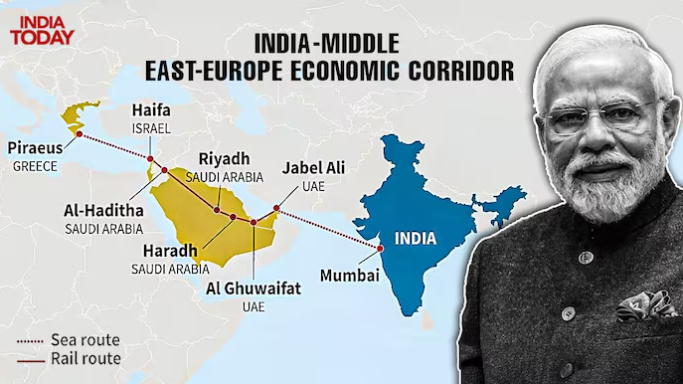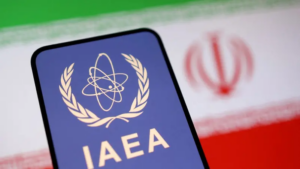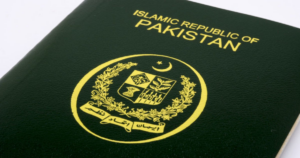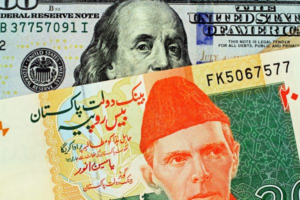
“India-Middle East-Europe Corridor (IMEEC) is vital for bilateral interests, enhancing strategic supply chains and boosting security in economic, energy, and health sectors across India, Europe, and the Middle-East,” PM Modi said after he reviewed the project along with French President Emmanuel Macron on Wednesday.
Both PM Modi and Macron agreed that the two countries should work more closely on building IMEEC. The two leaders stressed the importance of IMEC to foster connectivity, sustainable growth trajectories and access to clean energy across these regions.
WHAT IS IMEEC?
The IMEEC, launched on the margins of the G20 Summit in Delhi in September 2023, is an important project as it passes through Marseille in the Mediterranean Sea. On 9 September, 2023 the Memorandum of Understanding (MoU) was signed during the 2023 G20 New Delhi summit by the governments of India, United States, United Arab Emirates, Saudi Arabia, France, Germany, Italy and the European Union.
The IMEEC aims to integrate India, Europe, and the Middle-East through UAE, Saudi Arabia, Jordan, Israel and the European Union. The route, currently being used to bypass the Houthi blockade, is widely seen as a way to future proof the India-Europe-US supply chain avoiding the Suez canal.
“The IMEEC will comprise of two separate corridors, the east corridor connecting India to the Gulf and the northern corridor connecting the Gulf to Europe. The corridor intends to enhance connectivity, increase efficiency, reduce costs, secure regional supply chains, increase trade accessibility, generate jobs and lower greenhouse gas emissions, resulting in a transformative integration of Asia, Europe and Middle East,” the Ministry of External Affairs said in a statement last year.
The implementation of the IMEEC involves multiple stakeholders and is at an initial stage, Minister of State for External Affairs Kirti Vardhan Singh told parliament in a written reply in August 2024.
It added that an Intergovernmental Framework Agreement (IGFA) between India and the United Arab Emirates (UAE) concerning cooperation for operation of the IMEEC was signed on 13 February 2024. The main elements of the Framework include development and management of a logistics platform, including a digital ecosystem, and provision of supply chain services to handle all types of general cargo, bulk, containers and liquid bulk in order to enable IMEEC.
The IMEEC seeks to mobilise $600 billion by 2027 to address infrastructure gaps in partner countries. The memorandum of understanding on IMEEC outlines political commitments from the participants and does not establish legal rights or obligations.
HOW WOULD IT BENEFIT INDIA?
“India-Middle East-Europe Economic Corridor (IMEC) is an important initiative that can add to India’s maritime security and faster movement of goods between Europe and Asia,” Union minister Piyush Goyal had said at the Confederation of Indian Industry (CII) India-Mediterranean Business Conclave last year while emphasising the significance of the project.
Strengthening Maritime Security
A fully operational IMEEC promises to bolster India’s maritime security while expediting the movement of goods between Europe and Asia. The initiative not only enhances India’s shipping capabilities and port infrastructure but also acts as a strategic countermeasure to China’s Belt and Road Initiative.
Promoting Regional Stability
IMEEC will contribute to regional stability and peace by aligning with the European Nations’ Global Gateway program. By fostering robust diplomatic ties and encouraging normalisation between Middle Eastern nations, the corridor can help create a more secure and stable environment in a historically volatile region.
Streamlined Trade Corridor
A stabilised trade corridor under the IMEEC framework will streamline logistics and ensure the continuous, dependable flow of products, renewable energy, and information. With established logistical centers, road networks, and seaports in key member states, India stands to benefit from enhanced trade connectivity with Europe and its neighbours.
Boosting Trade Demand and Supply
The corridor will also drive a significant increase in trade demand and supply across the region, reducing transaction costs and creating new job opportunities. IMEEC will facilitate industrial development and improve access to the European market, further securing India’s supply chain through improved logistical services.
Enhancing Cultural Exchange
Beyond economic benefits, IMEEC offers a vital platform for cultural and political exchange. By facilitating cross-cultural interactions and fostering mutual understanding, the initiative can bridge ideological and religious divides, promoting tourism, educational opportunities, and a more integrated regional identity.
Advancing Energy, Hydrogen, and Technology Sectors
IMEEC’s expansive vision extends into the energy and technology sectors, incorporating initiatives such as integrated electricity grids, clean hydrogen pipelines, and secure high-speed data connectivity. These advancements align with India’s leadership in renewable energy and digital innovation, positioning the nation as a pivotal player in shaping a sustainable, technologically advanced future across the region.







